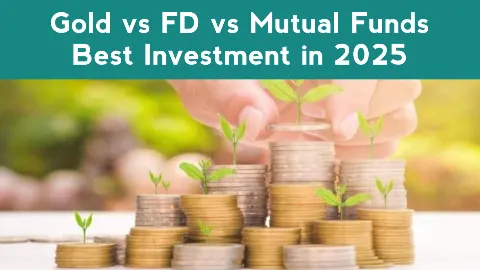Introduction: The Eternal Investment Question Gets a 2025 Makeover
For generations, Indian investors have debated the holy trinity of savings: the timeless allure of Gold, the steadfast security of Fixed Deposits (FDs), and the dynamic growth potential of Mutual Funds. In 2025, with evolving economic conditions, this choice is more nuanced than ever. The “best” investment isn’t a single product, but a strategy that aligns with your financial goals, risk tolerance, and time horizon.
This guide breaks down each asset class to help you build a portfolio that doesn’t just save money, but grows it intelligently.
The Contenders: A Detailed Breakdown
1. Gold: The Timeless Safe Haven
Gold has transcended its role as jewelry to become a strategic asset class, especially in volatile times.
- Key Characteristics:
- Inflation Hedge: Historically, gold preserves purchasing power when currency values decline.
- Safe-Haven Asset: During geopolitical uncertainty or market crashes, gold prices often rise as investors seek safety.
- Liquidity: Easily bought and sold in various forms (physical, digital, ETFs).
- The 2025 Outlook: Demand remains robust, supported by central bank buying and its role in a diversified portfolio.
- The Downsides:
- No Regular Income: It doesn’t pay interest or dividends. Returns rely solely on price appreciation.
- Storage & Making Charges: Physical gold involves security costs and jewelry carries high making charges that erode returns.
- Price Stagnation: It can go through long periods of low returns.
- Best For: Portfolio diversification, long-term wealth preservation, and a hedge against economic uncertainty.
2. Fixed Deposits (FDs): The Pillar of Predictability
FDs are the bedrock of conservative investing in India, offering capital protection and assured returns.
- Key Characteristics:
- Capital Safety: Deposits are insured up to ₹5 lakhs per bank by DICGC.
- Guaranteed Returns: You know the exact maturity amount at the time of investment.
- Disciplined Saving: Lock-in periods discourage impulsive withdrawals.
- The 2025 Outlook: Interest rates are expected to remain in the 6-8% range, making them stable but modest.
- The Downsides:
- Inflation Risk: Post-tax returns often fail to beat inflation, leading to negative real returns.
- Tax Inefficiency: Interest earned is fully taxable according to your income slab.
- Liquidity Penalty: Premature withdrawals attract a penalty, reducing your effective return.
- Best For: Short-term goals, emergency funds, and risk-averse investors seeking absolute capital protection.
3. Mutual Funds: The Engine of Growth
Mutual Funds offer a gateway to professional management of stocks and bonds, making them a powerful tool for wealth creation.
- Key Characteristics:
- Diversification: A single fund holds shares in dozens or hundreds of companies, spreading risk.
- Professional Management: Expert fund managers make investment decisions on your behalf.
- Flexibility & Accessibility: You can start with a small SIP (as low as ₹500) and choose from equity, debt, or hybrid funds based on your goal.
- The 2025 Outlook: Equity markets, while volatile, continue to offer the highest potential for long-term growth, with historical averages of 10-12%+.
- The Downsides:
- Market Risk: The value of your investment fluctuates with the market; negative returns are possible in the short term.
- No Guarantees: Unlike FDs, returns are not assured.
- Requires Discipline: Success hinges on staying invested through market cycles, not timing the market.
- Best For: Long-term wealth creation (5+ years), achieving financial goals like retirement, and investors comfortable with some volatility for higher potential returns.
Head-to-Head Comparison
| Feature | Gold | Fixed Deposit (FD) | Equity Mutual Fund |
|---|---|---|---|
| Primary Goal | Safety & Hedge | Capital Protection | Wealth Creation |
| Potential Return | Moderate | Low | High |
| Risk Level | Low | Very Low | Moderate to High |
| Liquidity | High | Medium (penalty on early withdrawal) | High |
| Tax Efficiency | Low (LTCG after 3 years) | Low (Taxable as per slab) | High (LTCG with indexation) |
| Best Suited For | Diversification, Crisis Insurance | Short-term goals, Emergency Corpus | Long-term goals (Retirement, Child’s Edu) |
The Verdict: Don’t Choose—Combine
The most successful investors don’t pick one; they blend all three to create a resilient portfolio. Here’s how to think about allocation:
- The Safety Layer (FDs): Allocate a portion to FDs for your emergency fund and near-term goals (within 3 years). This is your financial anchor.
- The Stability & Hedge Layer (Gold): Allocate 5-15% of your portfolio to gold (preferably via Digital Gold or Gold ETFs to avoid storage issues). This acts as your insurance policy against inflation and global turmoil.
- The Growth Layer (Mutual Funds): Allocate the largest portion to a diversified set of equity and debt mutual funds for your long-term goals (5+ years). This is the engine that will drive your wealth creation.
Real-World Scenario:
- Priya (25, starting her career): 70% Mutual Funds, 20% FD, 10% Gold. She can take more risk for long-term growth.
- Mr. Sharma (50, planning retirement): 40% Mutual Funds, 40% FD, 20% Gold. He’s preserving capital while still seeking growth.
Conclusion: Your Portfolio, Your Strategy
In 2025, the question isn’t “Which is best?” but “What is the best mix for me?” A diversified portfolio that includes the safety of FDs, the stability of Gold, and the growth potential of Mutual Funds is your strongest defense against market volatility and your best offense for building long-term wealth.
Your financial journey is unique. Start by defining your goals, assess your risk tolerance, and build your personalized investment pyramid today.
Need help figuring out your ideal asset allocation? Use our simple framework above as a starting point and share your thoughts in the comments below!






